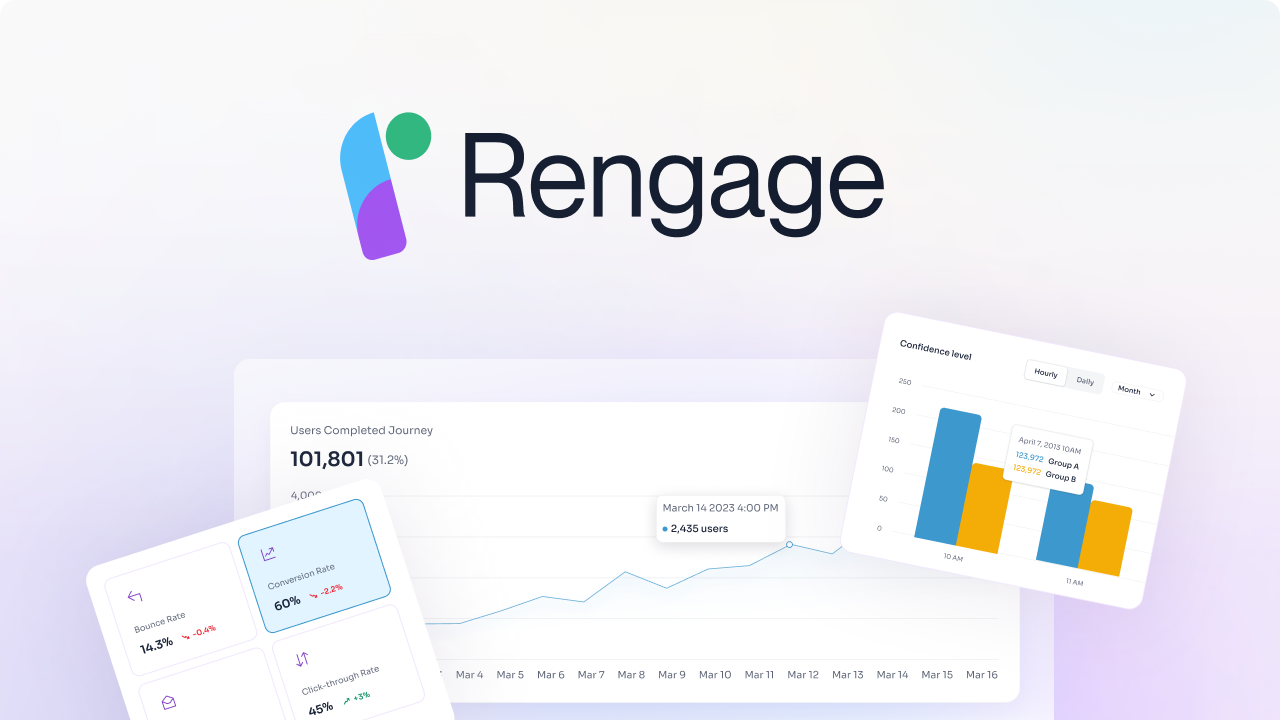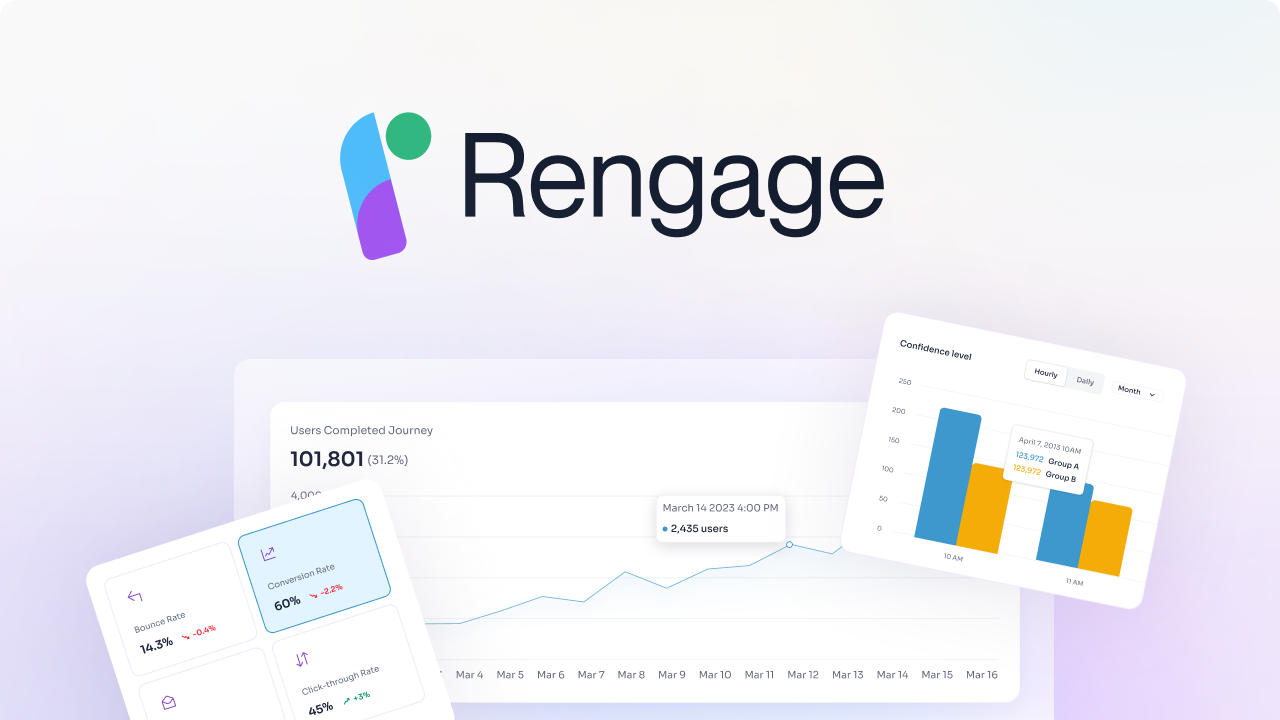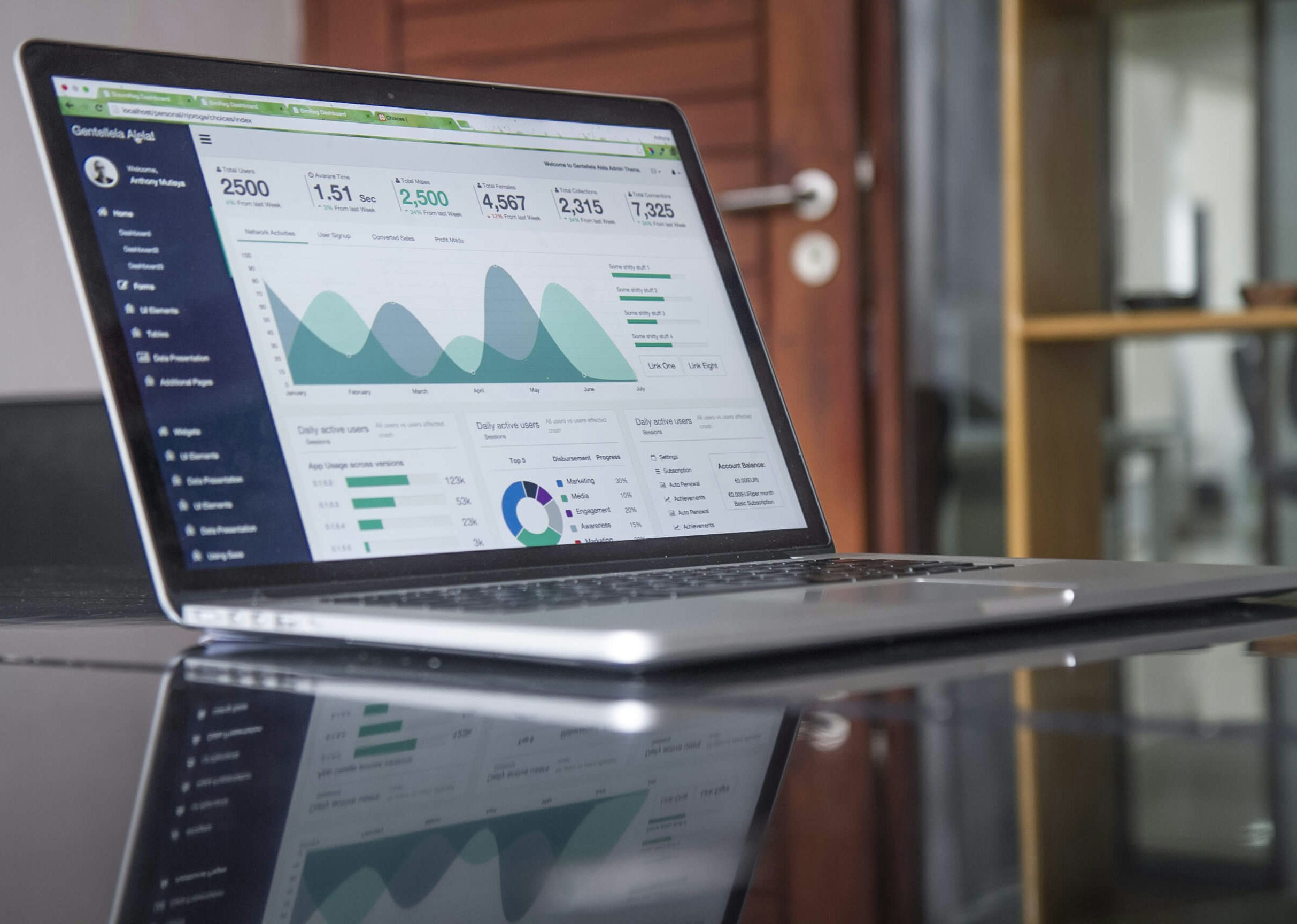Why Your Sales Team Needs an Omnichannel CRM (8 Top Software)
Are you in a predicament where the information you need is scattered across various platforms? That's where omnichannel CRM comes into play. This technology enables you to create a seamless omnichannel customer experience. But why exactly does your sales team need an omnichannel CRM? How can they benefit, and what are your top picks? Stick around to find out!
Looking to streamline your operations quickly and effectively? The Rengage omnichannel marketing platform is the tool you need to help your team achieve their goals.
Table of Contents
- What is an Omnichannel CRM?
- Benefits of an Omnichannel CRM for Your Sales Team
- Advanced Omnichannel CRM Features
- Top 8 Omnichannel CRM Software
- Choosing the Perfect Omnichannel CRM
- Frequently Asked Questions about Omnichannel CRM
- Create Personalized Experiences That Drive Loyalty and Growth with Rengage's Omnichannel Marketing Platform
What is an Omnichannel CRM?

An omnichannel CRM is a centralized platform that unifies all your customer data from various channels. Imagine a social media interaction seamlessly connecting with a past email exchange, all accessible within the same platform. This empowers your sales reps to have a complete picture of each customer and deliver a personalized touch that resonates.
Unified Customer Data
An omnichannel CRM aggregates all customer interactions across various channels into one place, providing a 360-degree view of each customer. No more missing puzzle pieces.
Seamless Customer Experience
Say goodbye to repeating the same information. An omnichannel CRM ensures that customers feel like they are talking to one person, no matter how many channels they use.
Easy Transition Between Channels
A customer can reach out on chat, then switch to email, and continue the conversation on the phone, all without repeating themselves. Easy peasy.
Better Insights
By analyzing customer interactions across all channels, you can identify trends, preferences, and pain points, which can help you improve your services.
Improved Personalization
An omnichannel CRM makes it easier to deliver personalized experiences since you have a complete picture of the customer.
Increased Efficiency
No more switching between platforms or losing track of leads. An omnichannel CRM streamlines your sales process and makes your team more effective.
Related Reading
- Omnichannel Marketing Tools
- Omnichannel eCommerce
- Omnichannel Marketing Strategy
- Omnichannel Personalization
- Omni Channel Marketing Examples
- Omni Channel Customer Engagement
- Omnichannel Marketing Automation
- Multichannel Marketing Automation
- Marketing Automation ROI
Benefits of an Omnichannel CRM for Your Sales Team

Delivering Stellar Customer Experiences
An omnichannel CRM equips sales reps to provide exceptional experiences at every touchpoint.
Personalized Interactions
Gone are the days of generic sales pitches. With a complete customer history, reps can tailor their communication based on:
- Past interactions
- Purchase preferences
- Online behavior
Imagine a rep referencing a customer's recent social media post about a specific product feature, demonstrating genuine interest and building trust.
Seamless Conversations Across Channels
Customers don't like starting conversations from scratch. An omnichannel CRM allows reps to pick up conversations seamlessly across different channels. For example, if a customer initiates a chat but needs to step away, the rep can follow up with an email summarizing the conversation and next steps, ensuring a smooth and frustration-free experience.
Boosting Lead Management
Capturing and nurturing leads involved juggling various tools and spreadsheets. An omnichannel CRM streamlines this process, transforming lead management into a well-oiled machine.
Unified Lead Capture
No more lost leads! An omnichannel CRM integrates with your website forms, social media lead magnets, and offline sources like trade shows. All lead data is captured and automatically entered into the CRM, ensuring no potential customer slips through the cracks.
Automated Lead Nurturing
Stop wasting time on repetitive tasks. Omnichannel CRMs allow you to set up automated workflows that nurture leads based on their behavior and preferences. For instance, a lead downloading a white paper on a specific product might receive automated email sequences with relevant case studies and product demos, gradually moving them down the sales funnel.
Supercharging Sales Productivity
Sales reps' time is a precious commodity. An omnichannel CRM equips them with the tools to be laser-focused and maximize productivity.
Automated Tasks
Say goodbye to monotonous tasks like scheduling follow-up emails or manually logging call notes. Omnichannel CRMs automate these activities, freeing up valuable time for reps to focus on high-impact activities like building relationships and closing deals.
Real-Time Data at Your Fingertips
No more digging through spreadsheets or relying on memory. Omnichannel CRMs provide real-time data on leads and opportunities. Reps can see the progress of deals, identify potential roadblocks, and prioritize their actions accordingly. This data-driven approach allows them to close deals faster and achieve higher sales quotas.
Gaining Unparalleled Sales Visibility
Sales managers are responsible for ensuring their team's peak performance. An omnichannel CRM gives them the insights to make informed decisions and optimize sales strategies.
Actionable Metrics
Forget vanity metrics. Omnichannel CRMs track key metrics that matter, such as:
- Lead conversion rates
- Sales cycle length
- Individual rep performance
These metrics provide valuable insights into your sales process's effectiveness and identify improvement areas.
Real-Time Reporting and Analytics
Gone are the days of waiting for end-of-month reports. Omnichannel CRMs offer real-time reporting and analytics dashboards. Sales managers can track progress, identify trends, and adjust their strategies on the fly, ensuring your sales team stays ahead.
Fostering Collaboration and Teamwork
The best sales teams don't operate in silos. An omnichannel CRM fosters a collaborative environment where reps can work together seamlessly.
Centralized Information Sharing
An omnichannel CRM is a single truth source for all customer data. Reps can access notes, communication history, and activity logs for every interaction, eliminating the risk of missed information or conflicting communication.
Internal Messaging and Communication
Streamline communication within your sales team. Omnichannel CRMs often have built-in messaging features allowing reps to collaborate on deals, share insights, and ask for quick advice from colleagues. This fosters a culture of teamwork and ensures everyone is on the same page, leading to more successful sales outcomes.
Building Stronger Customer Relationships
Sales aren't just about transactions; they're about building long-term relationships. An omnichannel CRM empowers your sales team to nurture these relationships and create loyal customers.
Proactive Engagement
An omnichannel CRM provides a 360-degree view of your customer. Reps can leverage this data to identify opportunities for proactive engagement. For example, a rep might send a personalized email congratulating a customer on their company anniversary or offering relevant product suggestions based on past purchases. These small gestures go a long way in strengthening customer relationships and increasing brand loyalty.
Improved Customer Retention
Happy customers become loyal customers. By providing exceptional experiences and fostering solid relationships, your sales team can leverage an omnichannel CRM to improve customer retention rates. This translates to recurring business and a more predictable revenue stream.
Personalized Customer Journeys
Book a free demo to transform customer interactions into personalized experiences that drive loyalty and growth with our omnichannel marketing platform.
Advanced Omnichannel CRM Features

AI in Omnichannel CRM is transforming sales by utilizing customer data to provide:
- Valuable insights
- Personalize engagement
- Automate tasks
- Enhance customer service
Imagine CRM-powered chatbots qualifying leads and automating tasks like scheduling meetings, freeing up sales reps to focus on building strong customer relationships and closing deals.
AI’s ability to analyze customer data and past interactions enables it to predict future needs, offer upselling opportunities, and help you develop more personalized sales journeys that engage customers effectively.
Supercharged Sales Automation Tools
AI and automation tools empower sales teams to work more efficiently and achieve better results. CRM automation can create personalized email nurture campaigns with dynamic content tailored to each customer's profile, send targeted emails with product recommendations, and trigger notifications based on customer actions.
Prioritize Prospects and Automate Workflows
The dynamic lead scoring system ensures that your reps focus on the hottest leads most likely to convert. Streamlined workflows automate repetitive tasks, such as:
- Follow-up emails after website visits
- Triggering notifications based on customer actions
- Automatically scheduling demos when leads reach a specific stage in the sales funnel.
AI-powered proposal generation saves time by populating proposals with relevant customer data, product information, and pricing details, ensuring a personalized and efficient experience.
Top 8 Omnichannel CRM Software
1. Rengage (rengage.ai)

Book a free demo to transform customer interactions into personalized experiences that drive loyalty and growth with our omnichannel marketing platform.
2. HubSpot CRM
HubSpot CRM is a free option that is ideal for small businesses. It provides a solid range of features for getting started, such as:
- Contact management
- Lead scoring
- Email marketing capabilities
HubSpot CRM integrates seamlessly with other HubSpot products, such as marketing automation and content management tools, creating a unified platform for your marketing and sales efforts.
3. Zoho CRM
Zoho CRM balances affordability and feature richness, making it a great choice for many businesses. It includes functionalities like:
- Sales automation
- Lead management
- Opportunity management
- Customer service
Zoho CRM boasts many integrations with other Zoho products, such as marketing automation and accounting software, streamlining your business processes.
4. Freshworks CRM
Freshworks CRM is a cloud-based solution designed with ease of use in mind. It offers features including:
- Contact management
- Lead scoring
- Opportunity management
- Customer service functionalities
Freshworks CRM stands out for its user-friendly interface and even provides a free plan for small businesses to start.
5. Microsoft Dynamics 365 Sales
Microsoft Dynamics 365 Sales is a robust and scalable CRM that integrates with the entire Microsoft Dynamics 365 suite of business applications. This solution is designed for large enterprises and offers extensive customization capabilities.
6. Oracle NetSuite CRM
Oracle NetSuite CRM is another robust and scalable solution built for large enterprises. It integrates seamlessly with the Oracle NetSuite suite of business applications and is designed to handle the complex needs of large organizations.
7. SugarCRM
SugarCRM is an open-source CRM that offers a high degree of customization. This makes it suitable for businesses with unique needs requiring a highly tailored CRM solution. Since it's open-source, SugarCRM allows for extensive customization but may require additional development resources.
8. Insightly
Insightly is a cloud-based CRM designed for ease of use and collaboration. It includes:
- Contact management
- Lead scoring
- Opportunity management
- Project management functionalities
Insightly offers a free plan for small businesses to get started and is known for its user-friendly interface that fosters team collaboration.
Choosing the Perfect Omnichannel CRM

Scalability for Future Growth
As your company grows, your CRM needs to grow with it. Ensure the CRM you choose can adapt and expand alongside your business. Look for solutions that offer flexibility in user tiers, additional modules for specific needs, and seamless integration with future tools you might adopt.
Intuitive User Experience
A user-friendly interface is crucial for user adoption. The CRM shouldn't require extensive training or burden your sales team's time. Make sure you prioritize CRMs with:
- Clear dashboards
- Simple navigation
- Readily available support resources
Seamless Integrations
A CRM that integrates smoothly with your existing business ecosystem is essential. Ensure compatibility with your marketing automation platform, email service provider, accounting software, and other tools your sales team relies on. This eliminates data silos and fosters a unified customer experience.
Robust Security Measures
Customer data security should be a top priority. Choose a CRM that offers robust security features such as multi-factor authentication, data encryption at rest and in transit, and access controls. Look for providers that comply with relevant data privacy regulations.
Budget-Conscious Selection
Omnichannel CRMs cater to a variety of budgets. Identify the most critical features for your sales team's success and prioritize them during the selection process. Consider free trials and tiered pricing options to find the best value for your investment.
Frequently Asked Questions about Omnichannel CRM

What's the difference between a traditional CRM and an omnichannel CRM?
Traditional CRM
A traditional CRM is a digital on steroids. It excels at storing contact information, managing sales pipelines, and tracking deals. It often operates in a silo, meaning data from different communication channels like email, social media, or phone calls might be stored separately. This makes it challenging for sales reps to understand the customer journey completely.
Omnichannel CRM
On the other hand, an omnichannel CRM is like a unified command center for all your customer interactions. It acts as a central hub that gathers customer data from various channels like:
- Website forms
- Social media interactions
- Email exchanges
- hone calls.
This data is then integrated and presented in a single platform, offering a 360-degree view of your customer.
The Omnichannel Advantage
Imagine a customer browsing your website for a new pair of shoes, adding them to their cart, but abandoning the purchase. A traditional CRM might only show their contact details and the abandoned cart.
An omnichannel CRM might reveal that the customer also interacted with a live chat rep asking about sizing and later commented on a social media post featuring the same shoes. This comprehensive view empowers sales reps to personalize their outreach with a targeted email offering specific sizing advice or a discount code.
How can an omnichannel CRM improve my sales team's productivity?
Sales reps wear many hats – managing leads, nurturing prospects, closing deals, and building relationships. Traditional CRMs can add to the workload with manual data entry and repetitive tasks. Omnichannel CRMs become a productivity game-changer by:
Automating Repetitive Tasks
No more wasting time manually logging call notes or scheduling follow-up emails. Omnichannel CRMs automate these activities, freeing up reps for high-value interactions with customers.
Real-Time Data at Your Fingertips
Gone are the days of digging through spreadsheets or relying on memory. Omnichannel CRMs provide real-time data on leads and opportunities. Reps can see deal progress, identify potential roadblocks, and prioritize their actions based on the latest information.
Facilitating Collaboration
Sales is a team sport. Omnichannel CRMs often have built-in communication features that allow reps to collaborate on deals, share insights, and ask colleagues for quick advice. This fosters a collaborative environment and ensures everyone is on the same page, leading to faster deal closures.
No-Code Customer Journey Management
We provide a comprehensive solution for managing and enhancing customer journeys, delivering insights and measurable outcomes with no code. We accelerate your customer journey from onboarding, activation to conversion and churn. Enabling customers to unlock revenue from their existing user.
With Rengage, you can get insights into your segments, run campaigns with an intuitive journey manager, and get insights to measure how your journeys impact users conversion through our Journey Moments and Journey Builder features.
- Journey Moments: insights into your micro-segments
- Journey Builder: intuitive multi-channel marketing automation
- Insights prediction and attribution
Book a free demo to transform customer interactions into personalized experiences that drive loyalty and growth with our omnichannel marketing platform.
Related Reading
- Omnichannel Marketing Trends
- Challenges In Omnichannel Commerce
- Omnichannel Marketing Software
- Omnichannel Customer Experience Examples
- Benefits of Omnichannel Marketing
- B2B Omnichannel Marketing
- Omnichannel KPIs
- Omnichannel Lead Generation
- Omnichannel Reporting
- Omnichannel Best Practices
- Seamless Omnichannel Experience
What are some key features to consider when choosing an omnichannel CRM?
Scalability
Choosing an omnichannel CRM that can grow with your business is essential. Your CRM should be flexible enough to accommodate your expanding team and evolving business needs. Look for solutions that offer scalability to ensure your CRM remains relevant as your business flourishes.
Ease of Use
Ensure your omnichannel CRM is user-friendly and intuitive. A clean interface, easy navigation, and accessible training materials are vital for ensuring quick adoption by your team. Opt for a CRM that simplifies complex tasks and makes day-to-day operations more efficient.
Integrations
Your CRM should seamlessly integrate with your existing tools and systems. Whether it's marketing automation tools, email platforms, or other business systems, a well-integrated CRM can streamline workflows and improve productivity. Look for a CRM solution that works harmoniously with your existing tech stack.
Security
Protecting sensitive customer data is paramount. Choose an omnichannel CRM that offers top-notch security features, such as data encryption protocols and access control measures. Ensure your CRM safeguards your customer data against potential cyber threats or breaches.
Budget
Different omnichannel CRMs offer varying pricing structures. Consider your budget and select a CRM that not only fits your financial constraints but also offers the features you need. Explore freemium options, tiered pricing plans, or customizable packages to find a solution that aligns with your budget and requirements.
Create Personalized Experiences That Drive Loyalty and Growth with Rengage's Omnichannel Marketing Platform
Rengage offers a comprehensive solution for managing and enhancing customer journeys, delivering insights and measurable outcomes with no code. We speed up your customer journey from onboarding, activation to conversion and churn, helping customers unlock revenue from their existing user base. With Rengage, you can:
- Gain insights into your segments
- Run campaigns using an intuitive journey manager
- Measure how your journeys impact user conversion through our journey moments and journey builder features
Micro-Targeting and Automated Engagement
Our journey moments feature provides insights into micro-segments, while journey builder offers intuitive multi-channel marketing automation. Our platform includes insights prediction and attribution capabilities. Ready to learn how Rengage can help you transform customer interactions into personalized experiences that drive loyalty and growth?
Book a free demo today to delve into the possibilities.
Related Reading
- Hubspot vs Marketo
- Activecampaign Alternatives
- Constant Contact Alternatives
- Omnichannel Marketing Companies
- Getresponse Alternatives
- Hubspot Marketing Alternatives
- Salesforce Marketing Cloud Alternatives




















































